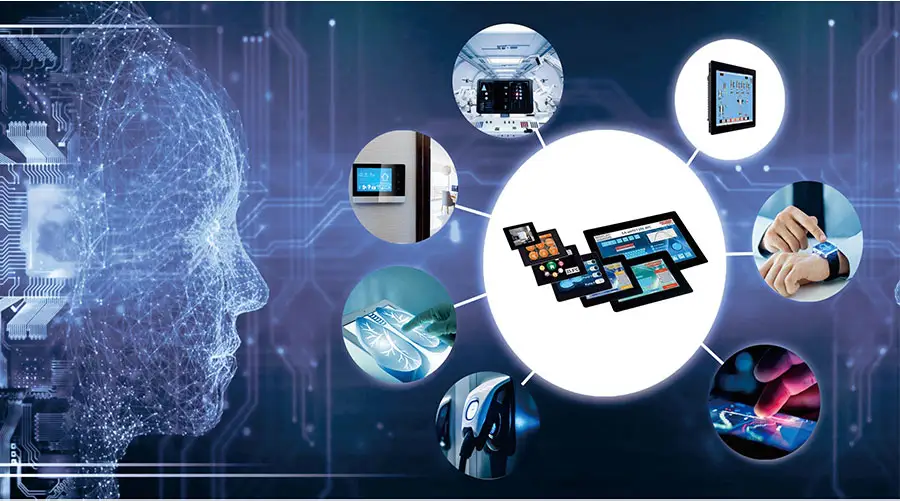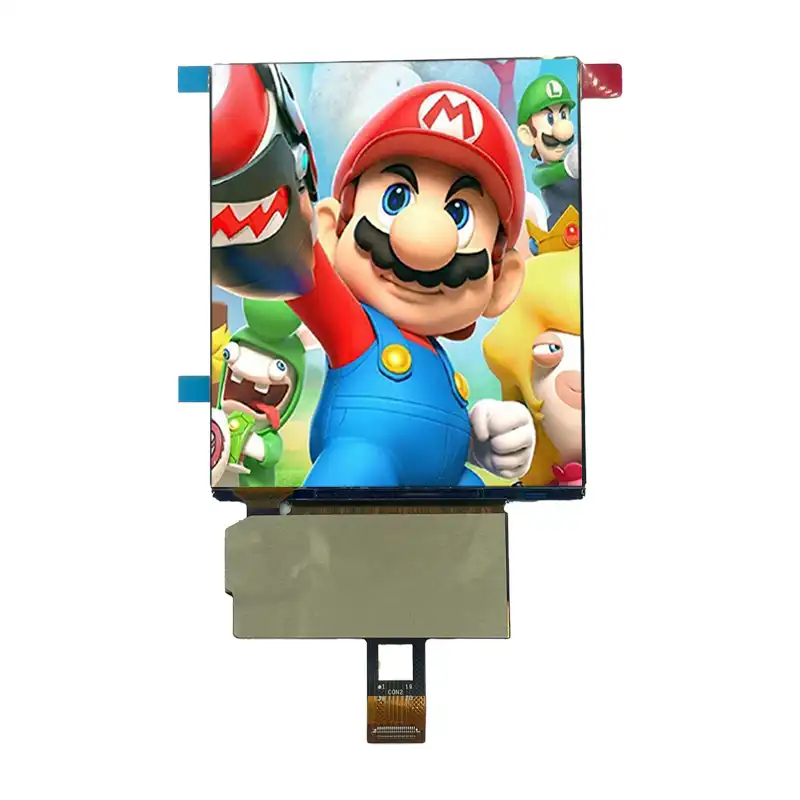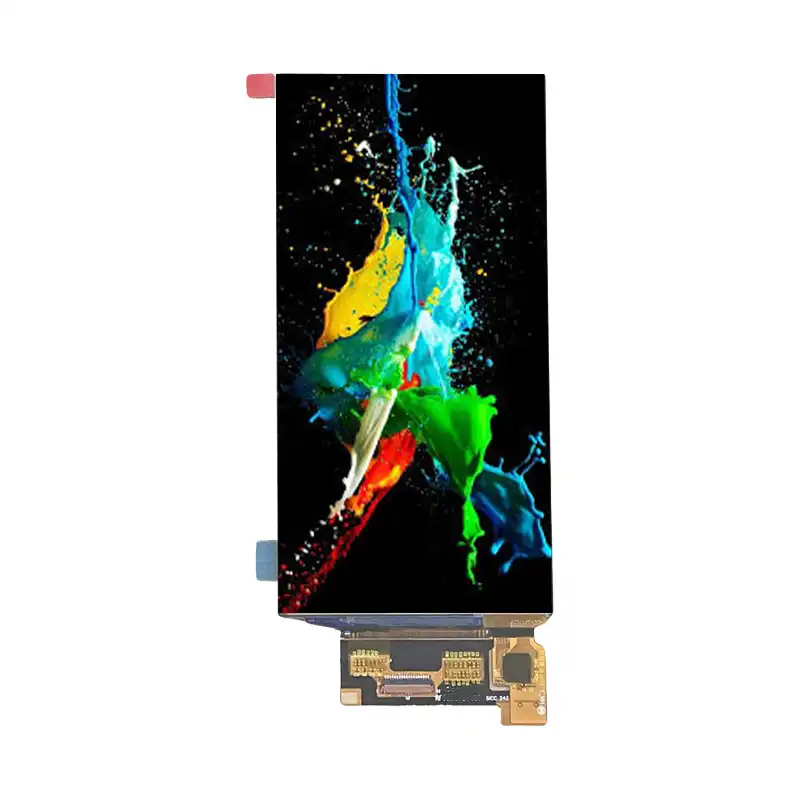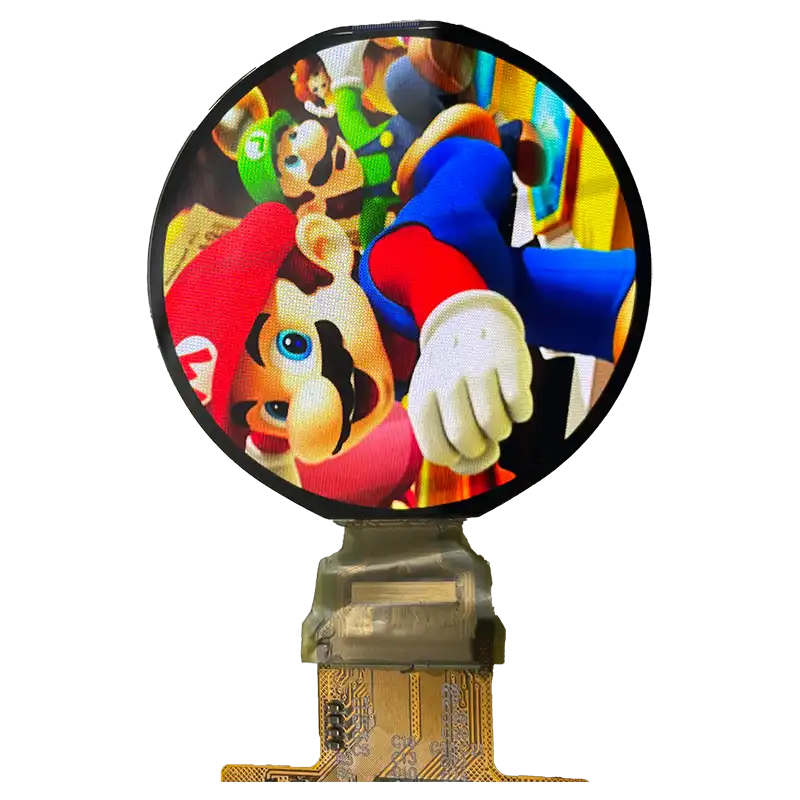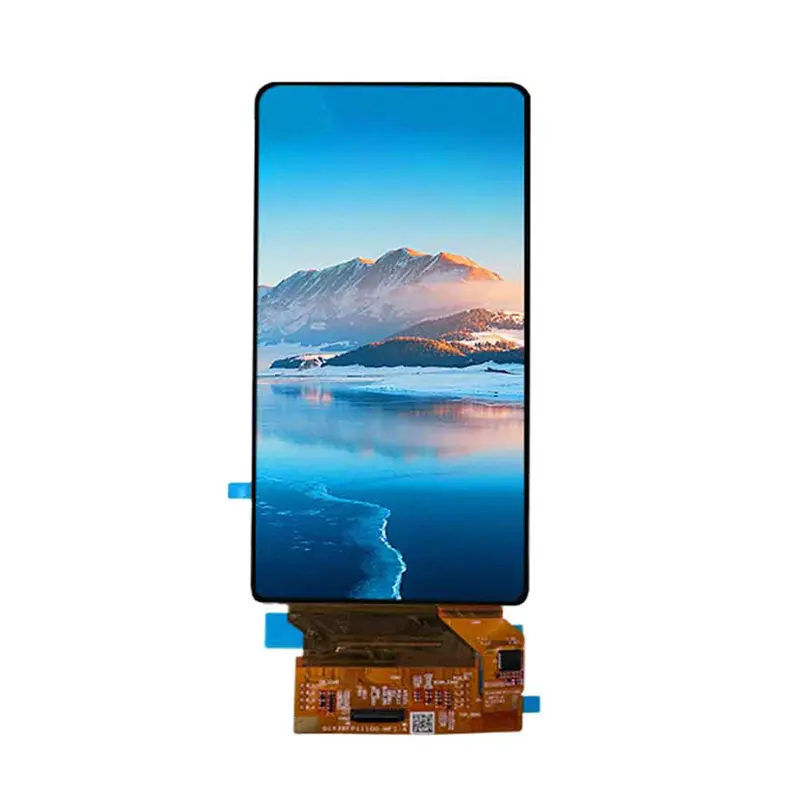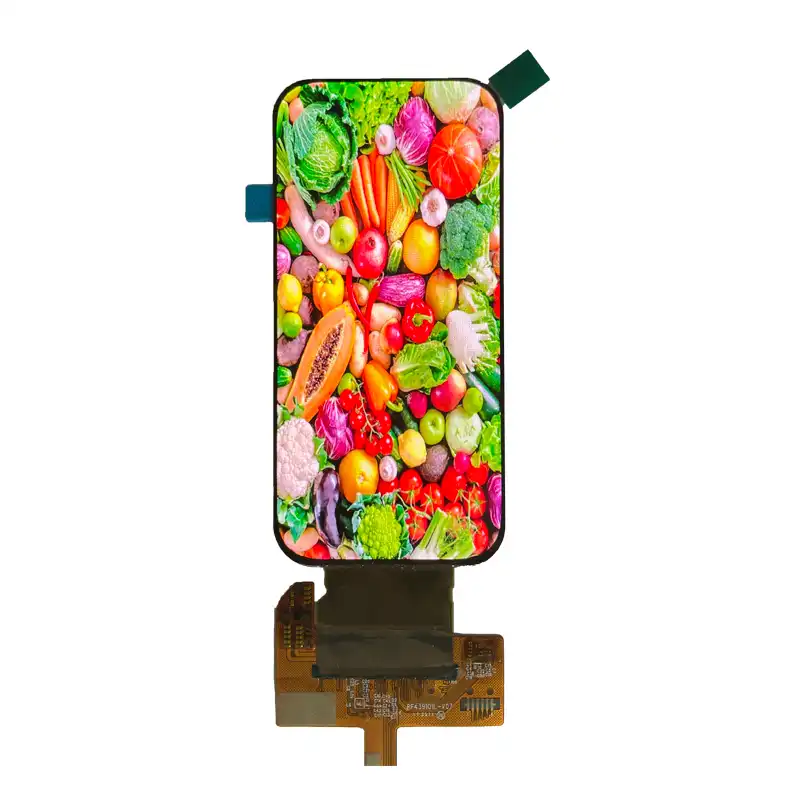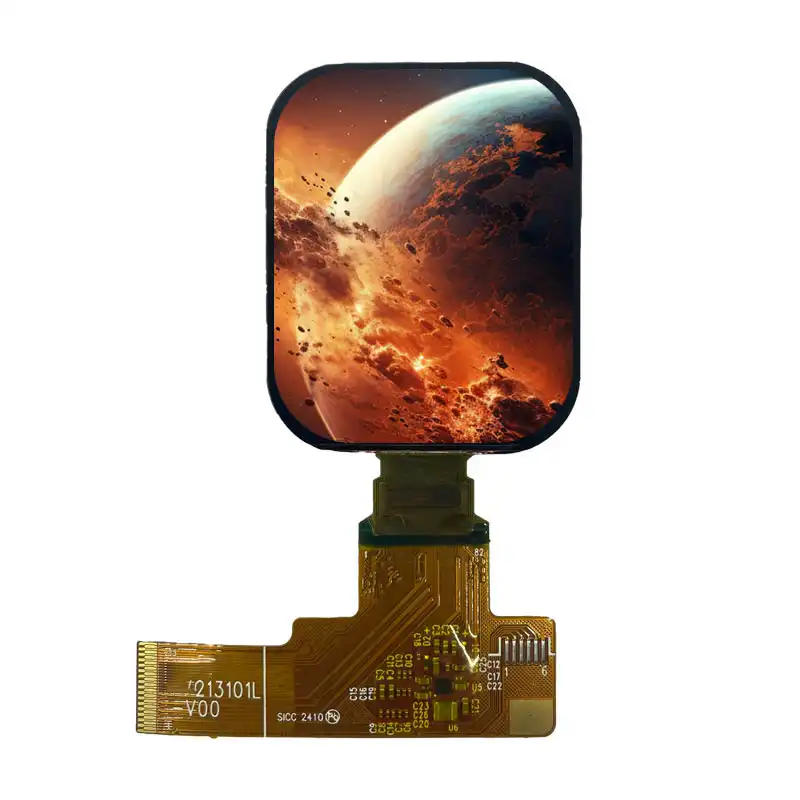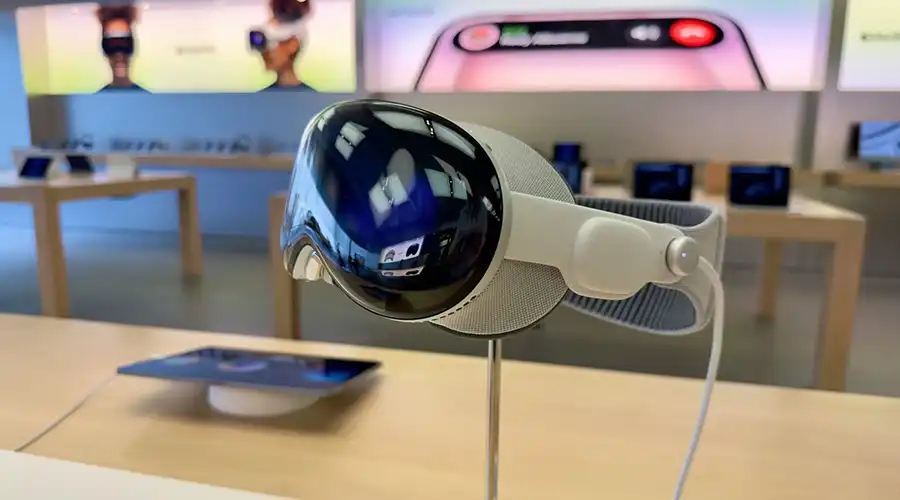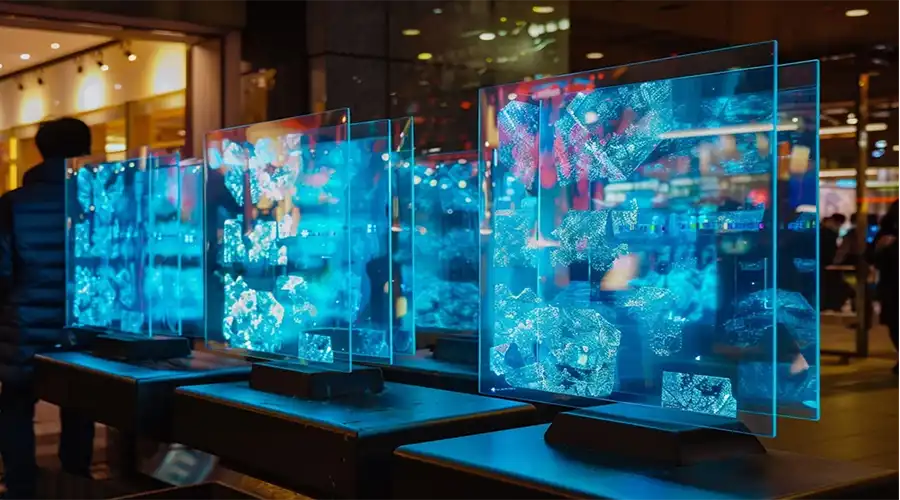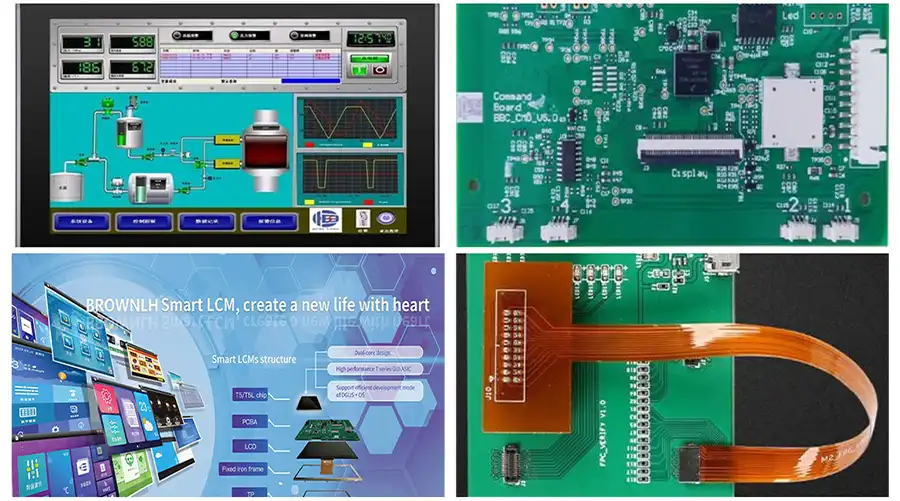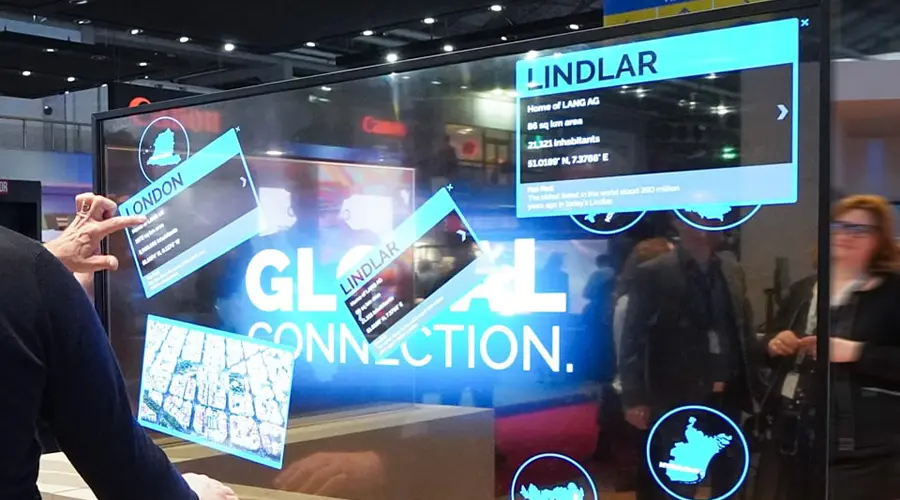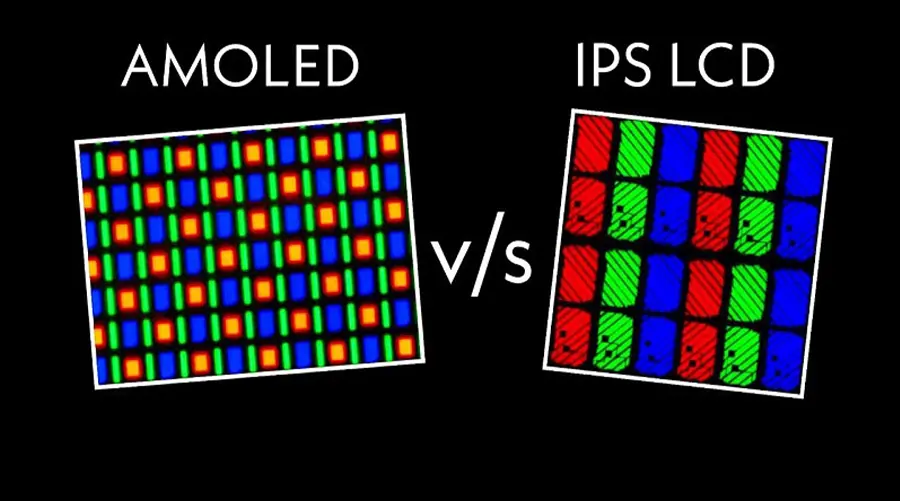I. What is OLED Display Technology?
OLED (Organic Light Emitting Diode) displays are "self-emissive", meaning each pixel generates light independently. This technology eliminates the need for a backlight, enabling:
True black & infinite contrast ratio
Thinner & lighter form factors
Flexible, foldable & transparent displays
Ultra-fast response for AR/VR and gaming
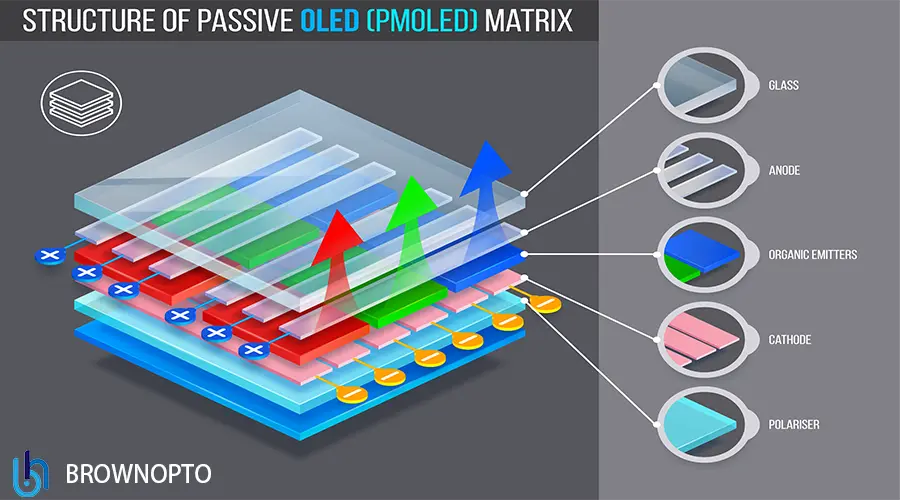
OLED has become the benchmark in premium devices (phones, wearables, TVs), and now expanding into "industrial, medical, transportation & retail electronics".
II. How OLED Pixels Work
Electroluminescence principle
Organic molecules emit light when electrons and holes recombine. People see the light directly from each pixel — no backlight, no light leakage.
OLED Device Layer Structure
Encapsulation layer (protects from moisture/O₂)
광 추출층
발광층(RGB 발광 분자)
전하 수송층(ETL/HTL)
투명 양극 + 금속 음극
TFT 액티브 매트릭스(LTPS 또는 IGZO)
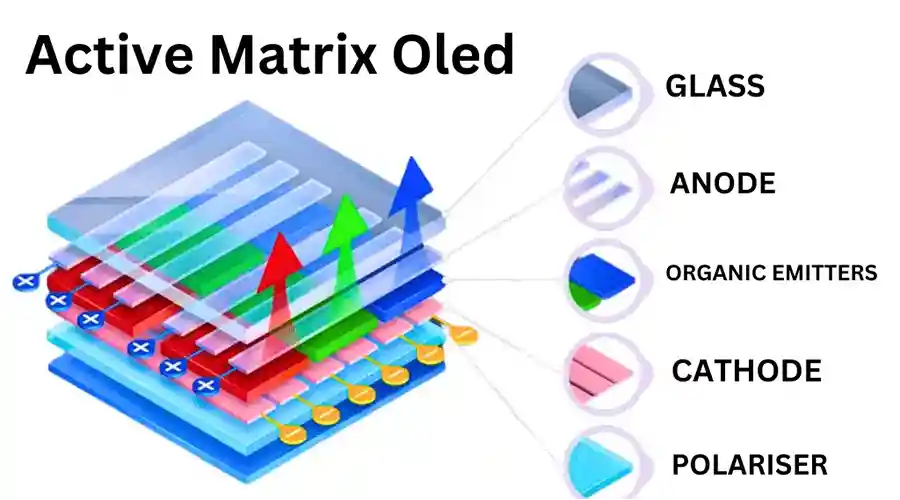
III. 주요 소재 및 구성 요소
방출기 - 형광등 vs 인광등 vs TADF
최신 AMOLED는 거의 100% IQE를 달성하는 "인광 방출체"(적색/녹색)를 사용하는 반면, 수명 개선을 위한 "청색 TADF"는 가장 인기 있는 R&D 초점입니다.
투명 전극
| 재료 | 사용 사례 | 유연성 |
|---|---|---|
| 이것 | 강성 OLED | 낮은 |
| 그래핀 | 플렉시블 OLED | 높은 |
| 은 나노와이어 | 곡면 웨어러블 디스플레이 | 높은 |
박막 캡슐화(TFE)
필수 WVTR: "< 10⁻⁶ g/m²/day"는 수년간의 운영 안정성을 보장합니다.
IV. OLED 제조 기술
OLED 제조는 반도체, 화학, 그리고 정밀 광학을 결합합니다. 가장 일반적인 기술은 다음과 같습니다.
증발 + 미세 금속 마스크(FMM)
스마트폰, 웨어러블에 사용
높은 PPI(>500), 정확한 RGB 정렬
10인치 이상 크기로 제한된 확장 가능
잉크젯 프린팅 OLED(IJP-OLED)
재료 활용 효율 >90%
대형 디스플레이(TV, 간판)에 적합
급속한 발전 속 비용 절감 로드맵
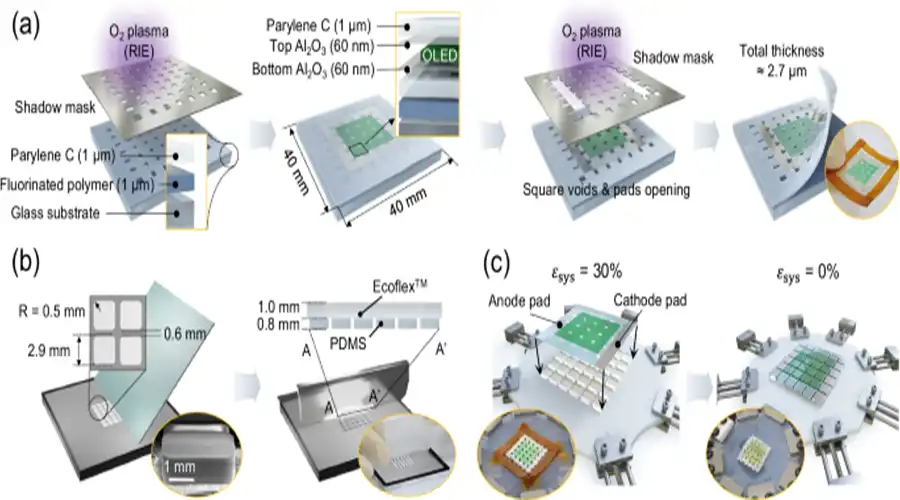
V. OLED 성능 엔지니어링
엔지니어는 밝기, 수명, 전력 및 열 안정성의 균형을 맞춰 설계를 최적화합니다.
밝기 및 야외 가시성
일반: 300~900니트(APL에 따라 다름)
MLA/탠덤 스택: 최대 2000니트 이상
의료 및 자동차에 중요
평생 신뢰성
| 색상 | 일반적인 LT97 수명 | 노트 |
|---|---|---|
| 녹색 | 5만~12만 시간 | 강력한 안정성 |
| 빨간색 | 4만~8만 시간 | 뛰어난 효율성 |
| 파란색 | 10,000~25,000시간 | TADF를 통해 계속 개선 중 |
UI 디자인중요: 정적 아이콘은 차등적 노화(번인)를 가속화합니다.
응답 시간
OLED 응답 속도는 "1μs"로 LCD보다 100배 빠르며 VR/AR 및 HUD에 이상적입니다.
VI. 주요 OLED 디스플레이 유형
강성 AMOLED(유리 기판)
비용 효율적인 성숙한 공급망
산업용 핸드헬드, HMI 모듈, 의료
유연하고 접을 수 있는 OLED
폴리이미드 기판은 곡선 및 접힘을 허용합니다.
웨어러블, 스마트 액세서리, 차량 내부
투명 OLED
투명도 40% 이상으로 효과를 보여주세요
소매, 박물관, 미래지향적 UX
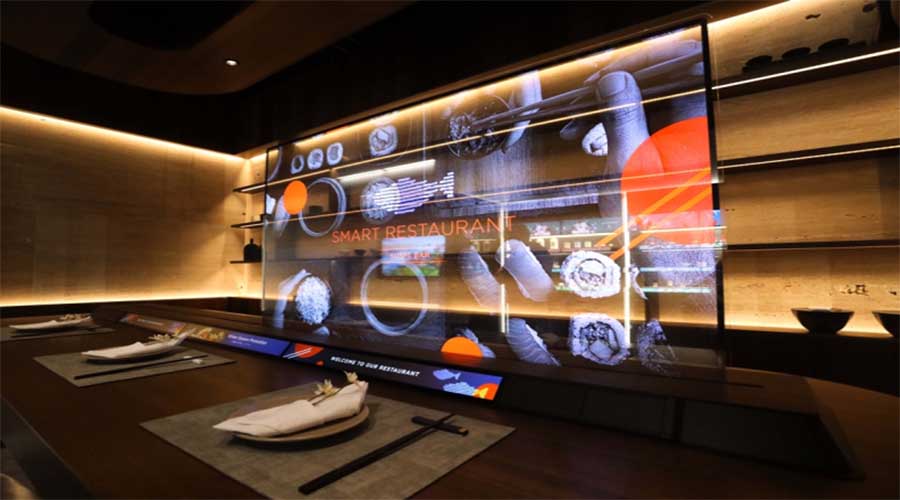
VII. OLED 디스플레이의 산업 응용 분야
1) 웨어러블 기술
저전력 AOD 모드
편안함을 위한 곡선 형태
야외 가독성 개선
2) 산업용 인간-기계 인터페이스
높은 대비 + 넓은 시야각
견고한 터치 시스템을 위한 광학 접합
장기 수명 UI 전략이 필요합니다.
3) 소매 및 투명 간판
프리미엄 그래픽으로 전환율 향상
플로팅 정보 디스플레이
4) 의료 및 계측
정밀 판독을 위한 높은 데이터 명확성
반사 방지/항균 코팅 옵션
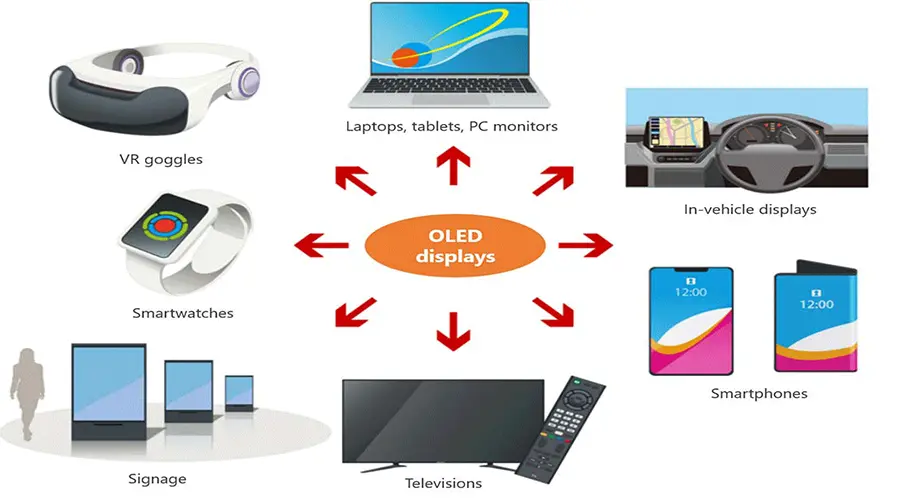
VIII. OLED 대 LCD 대 Mini-LED 대 MicroLED
| 측면 | 당신은 | 미니 LED(LCD) | 표준 LCD | 마이크로LED |
|---|---|---|---|---|
| 블랙 레벨 | 완벽한 블랙 | 로컬 디밍이 더 좋습니다 | 빛나고 번짐 | 완벽한 블랙 |
| 차이 | 무한 | 높은 | 낮은 | 무한 |
| 명도 | 좋은 | 매우 높음 | 높은 | 매우 높음 |
| 유연성 | 예 | 아니요 | 아니요 | 예 |
| 번인 위험 | 완화가 필요합니다 | 없음 | 없음 | 최소 |
| 비용 | 더 높은 | 상위-중위 | 낮추다 | 매우 높음 |
Conclusion:프리미엄 UX와 얇고 유연한 디자인이 필요할 때 OLED는 최고의 선택입니다.
IX. OLED의 새로운 트렌드와 미래
QD-OLED 및 하이브리드 접근 방식
퀀텀닷 OLED(QD-OLED)와 기타 하이브리드 방식은 OLED 발광층과 퀀텀닷 색 변환 필름 또는 색 향상 필름을 결합하여 인지되는 밝기와 색 볼륨을 향상시킵니다. QD-OLED는 OLED의 픽셀 단위 명암비를 유지하면서 최대 휘도와 채도를 향상시키는 것을 목표로 합니다. 이는 프리미엄 TV와 전문가용 모니터에 있어 매력적인 절충안입니다.
탠덤 OLED 및 스택형 아키텍처
탠덤 OLED 스택은 여러 개의 발광 유닛을 직렬로 배치하여 전류를 공유하고 발광체당 응력을 줄입니다. 탠덤 구조는 수명을 향상시키고, 사용 가능한 밝기를 높이며, 번인으로 이어지는 노화 차이를 완화합니다. 이러한 스택은 향상된 청색 화학 물질과 결합하여 장수명 상용 OLED 전략의 핵심입니다.
롤러블, 인쇄형 및 스트레처블 OLED
인쇄 전자 및 박막 봉지 기술의 발전으로 롤러블 TV, 컨포멀 사이니지, 섬유 내장형 디스플레이가 가능해졌습니다. 인쇄 OLED는 진공 증착 단계를 일부 제거하여 제조 자본 지출(CAPEX)을 절감하는 반면, 스트레처블 OLED 연구는 디스플레이가 피부나 직물에 밀착되는 웨어러블 및 의료용 통합을 목표로 합니다.
MicroOLED / 근거리 디스플레이 및 AR
실리콘 또는 CMOS 백플레인을 탑재한 MicroOLED 디스플레이(마이크로디스플레이)는 AR/VR 헤드셋에 매우 높은 픽셀 밀도를 제공합니다. OLED 마이크로디스플레이는 지연 시간을 최소화하고 높은 동적 범위를 지원하는데, 이는 몰입형 근거리 눈 시스템의 핵심 지표입니다.
지속 가능성 및 재료 효율성
업계는 희소 소재 사용량을 적극적으로 줄이고, 기판 및 레이어의 재활용성을 개선하며, 에너지 절감을 위해 구동 전자 장치를 최적화하고 있습니다. 수명주기 평가(LFA)와 친환경 설계는 디스플레이를 대규모로 도입하는 OEM의 구매 고려 사항으로 떠오르고 있습니다.
X. 사례 연구 - 휴대용 의료 기기용 BROWNOPTO 4.4인치 AMOLED 통합
프로젝트 개요
한 의료기기 OEM 업체는 휴대용 현장 진단 분석기에 작고 밝은 곳에서도 판독 가능한 디스플레이를 요구했습니다. 주요 제약 조건으로는 얇은 기계적 두께, 장갑 착용 시에도 사용 가능한 터치 기능, 임상적 가독성을 위한 높은 명암비, 그리고 -20°C ~ +70°C의 온도 범위에서도 뛰어난 현장 신뢰성이 있었습니다.
엔지니어링 솔루션
패널 선택: 밝기와 수명의 균형을 맞추기 위해 탠덤 발광 구조를 적용한 4.40인치 LTPS AMOLED.
터치 통합: 니트릴 장갑과 습한 환경에 맞춰 보정된 셀 내 투사형 정전식 터치.
광학: 반사 방지 편광판과 광학 접합(OCA)을 통해 햇빛 대비와 견고성이 향상되었습니다.
인터페이스: 안전한 시작 및 저전력 절전 모드를 위한 최적화된 전력 시퀀싱을 갖춘 MIPI DSI 2레인.
캡슐화: 박막 캡슐화(TFE)로 WVTR < 1e-6 g/m²/day를 제공하여 필드 수명을 연장합니다.
주요 사양 제공
| 매개변수 | 값 |
|---|---|
| 대각선 | 4.40인치 |
| 해결 | 568 × 1210 |
| 일반적인 밝기 | 600칸델라/m² |
| 차이 | ~100,000:1(일반) |
| 인터페이스 | MIPI DSI(2레인) |
| 작동 온도 | -20°C ~ +70°C |
| 캡슐화 | 박막 캡슐화(TFE) |
결과 및 현장 피드백
이 장치는 여러 진료소와 이동형 병동에서 12개월간 시범 운영되었습니다. 다양한 조명 환경에서도 뛰어난 가독성과 장갑 착용 시에도 일관된 터치 동작을 보였습니다. 디스플레이 성능과 관련된 현장 고장은 기록되지 않았으며, 탠덤 OLED 방식과 보정된 UI 전략 덕분에 번인 위험이 완화되었습니다.
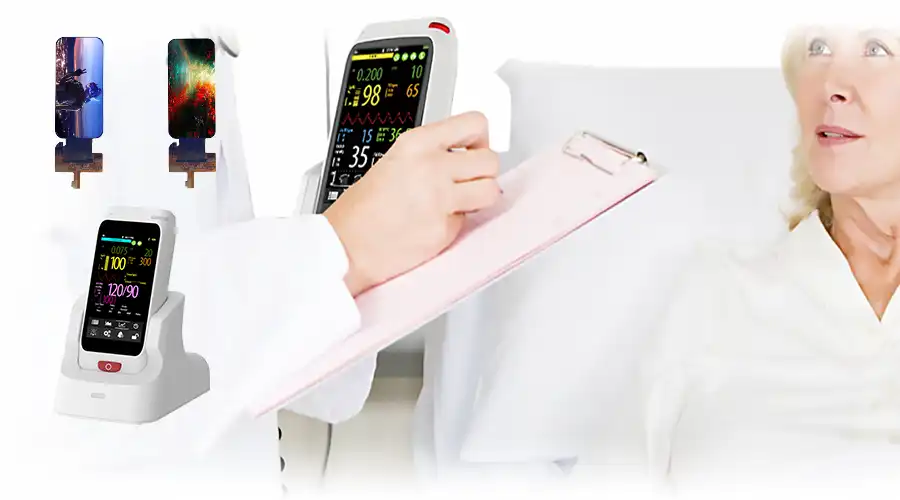
XI. 자주 묻는 질문
OLED와 AMOLED의 차이점은 무엇인가요?
OLED는 유기 발광 다이오드 디스플레이의 일반적인 종류입니다. AMOLED(Active Matrix OLED)는 박막 트랜지스터(TFT) 백플레인을 사용하여 픽셀을 능동적으로 처리하며, 스마트폰, TV 및 산업용 디스플레이에 적합한 고해상도 및 대형 패널을 지원합니다. PMOLED는 소형 저비용 화면에 적합한 수동 매트릭스 변형입니다.
OLED 디스플레이는 일반적으로 얼마나 오래 지속되나요?
수명은 발광체의 화학 성분, 패널 밝기, 열 설계 및 작동 패턴에 따라 달라집니다. 일반적인 상업용 AMOLED의 수명은 청색을 제외한 다른 색상의 경우 수만 시간에서 10만 시간 이상에 이릅니다. 청색 발광체의 수명은 여전히 제한 요소이며, 소재 연구 및 탠덤 구조를 통해 적극적으로 개선되고 있습니다.
OLED 디스플레이는 실외 간판에 적합할까요?
OLED는 높은 최대 휘도를 위해 설계되고 반사 방지 광학 장치와 결합될 경우 실외에서 사용할 수 있습니다. 그러나 직사광선이 강한 환경에서는 지속 최대 휘도가 높고 태양광 워시아웃(solar washout)에 대한 민감도가 낮은 고휘도 LCD/미니 LED 솔루션이 여전히 선호될 수 있습니다.
번인 현상은 무엇 때문에 발생하며, 어떻게 예방할 수 있나요?
번인은 정적인 고대비 콘텐츠를 장시간 표시할 때 유기 발광체의 불균일한 노화로 인해 발생합니다. 이러한 문제를 완화하기 위한 전략으로는 정적 요소를 줄이기 위한 UI 디자인, 픽셀 이동, 지속형 UI 요소의 밝기 제한, 예약된 콘텐츠 이동, 그리고 수명 향상을 위한 탠덤 발광 스택 사용 등이 있습니다.
OLED 디스플레이는 터치와 견고한 사용을 지원할 수 있나요?
네. 온셀(On-cell) 및 인셀(In-cell) 터치 아키텍처가 일반적입니다. 견고한 장비의 경우, 광학 본딩 및 내구성 있는 커버 렌즈(화학 강화 유리, AR/AG 코팅)와 컨포멀 실링(conformal seal)을 사용하여 환경 및 기계적 사양을 충족합니다.
OLED는 MicroLED와 어떻게 비교되나요?
맞춤형 OLED 디스플레이 솔루션이 필요하신가요?BROWNOPTO 엔지니어는 OEM과 협력하여 웨어러블, 의료, 산업 및 소매 제품에 맞춤형 AMOLED 모듈을 제공합니다.문의하기샘플, 데이터시트 및 NPI 지원을 받으세요.
최신 기사
-
2025년 AR/XR의 핵심은 1~2인치 AMOLED
AR/XR 붐에서 1~2인치 AMOLED 디스플레이가 필수가 되는 이유(2025년 산업 통찰력) 본문 {f
-
Understanding OLED Display Technology: Principles, Performance & Applications
OLED (Organic Light Emitting Diode) displays are a class of self-emissive display technology in whic
-
From Wearables to AR Glasses – How OLED Displays Are Redefining Visual Experiences in 2025
By 2025, OLED (Organic Light-Emitting Diode) technology has transitioned from luxury smartphone disp
-
Stretched Bar LCD Displays for Retail: Boost Sales & Engagement in Supermarkets
스트레치 바 LCD 디스플레이가 슈퍼마켓 선반 가장자리 마케팅을 향상시키고 매출을 늘리고 비용을 절감하는 방법을 알아보세요.
-
레스토랑 및 호스피탈리티 장소를 위한 스트레치 LCD 솔루션
스트레치 LCD는 레스토랑 메뉴와 호스피탈리티 서비스에 적합한 세련되고 고휘도 디스플레이를 제공합니다.
추천 상품
-
3.92 INCH OLED Screen I2C Interface 1080 × 1240 Resolution
제품 사양: BRO392001A 해상도: 1080x1024 작동 전압 범위: 28V 화면 크기: 3.92
-
6.01 INCH Display OLED screen | High Definition 1080x2160 | MIPI Interface
제품 사양: BRO601001A 디스플레이 모드: AMOLED 화면 크기(인치): 6.01 해상도: 1080x2
-
1.43 INCH Circular OLED 466x466 MIPI for Smartwatches/Industrial
1.43인치 AMOLED 디스플레이1.43인치 AMOLED 원형 디스플레이 모듈은 컴팩트한 스마트 디스플레이용으로 설계되었습니다.
-
6.39 INCH Outdoor AMOLED, 1080x2340, HD, High Brightness
제품 사양: BRO639001A 해상도: 1080x2340 전압: 2.8V 크기: 6.39인치 드라이버 IC: SD52
-
4.39 INCH OLED display module I2C Interface 568×1210 Resolution
(Shenzhen Brownopto Technology)가 출시한 4.39인치 AMOLED 디스플레이 모듈(모델 BR439102-A1)
-
2.08 INCH AMOLED Display 320×680 MIPI LTPS Module
2.08 INCH AMOLED 320×680 display, MIPI interface, 600nit brightness, wide viewing angle. Ideal for w

